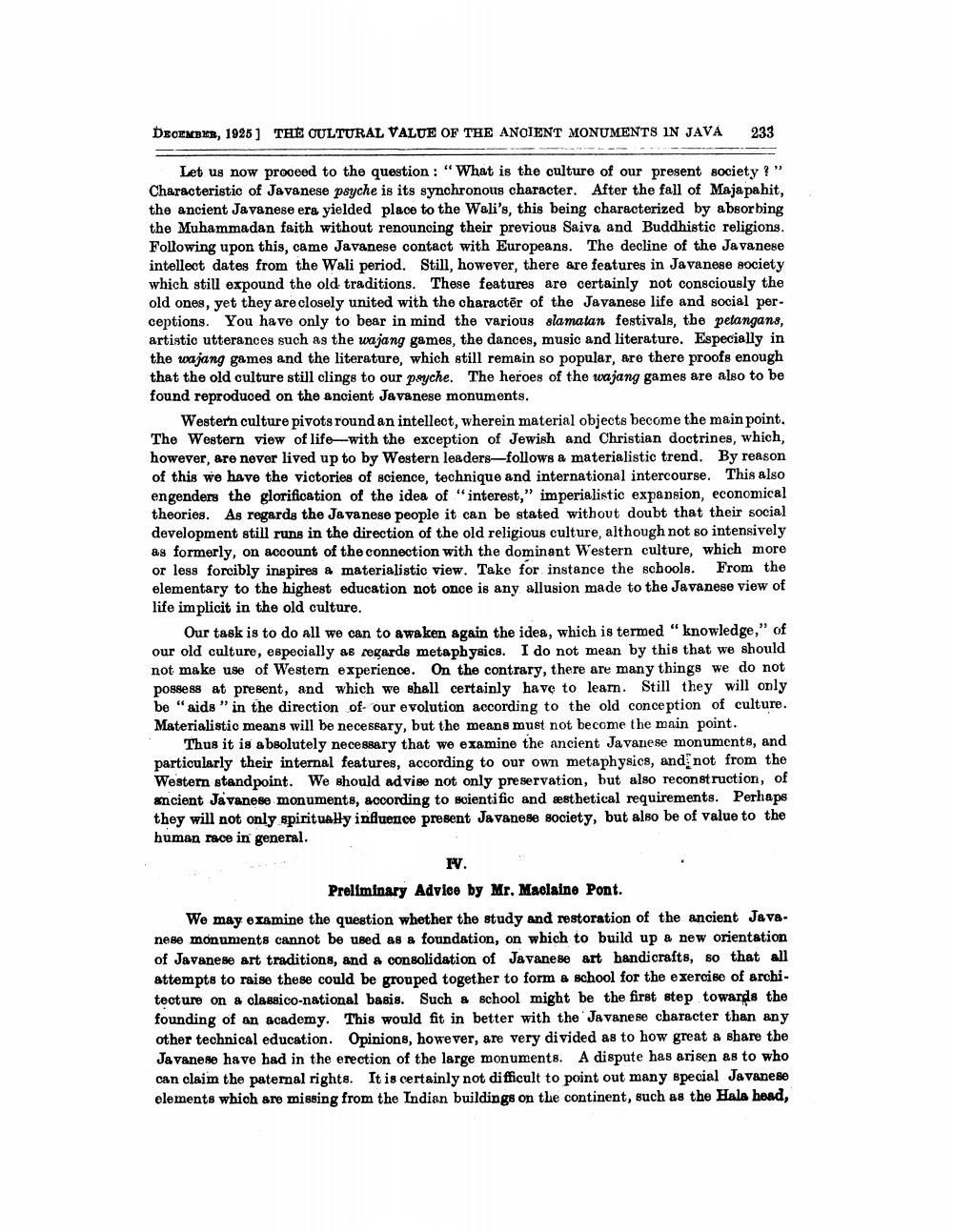________________
DECEMBER, 1926 ] THE CULTURAL VALUE OF THE ANCIENT MONUMENTS IN JAVA
233
Let us now proceed to the question: "What is the culture of our present society?" Characteristic of Javanese psyche is its synchronous character. After the fall of Majapahit, the ancient Javanese era yielded place to the Wali's, this being characterized by absorbing the Muhammadan faith without renouncing their previous Saiva and Buddhistic religions. Following upon this, came Javanese contact with Europeans. The decline of the Javanese intellect dates from the Wali period. Still, however, there are features in Javanese society which still expound the old traditions. These features are certainly not consciously the old ones, yet they are closely united with the charactēr of the Javanese life and social perceptions. You have only to bear in mind the various slamatan festivals, the petangans, artistic utterances such as the wajang games, the dances, music and literature. Especially in the wajang games and the literature, which still remain so popular, are there proofs enough that the old culture still clings to our peyche. The heroes of the wajang games are also to be found reproduced on the ancient Javanese monuments.
Western culture pivots round an intellect, wherein material objects become the main point. The Western view of life with the exception of Jewish and Christian doctrines, which, however, are never lived up to by Western leaders follows a materialistic trend. By reason of this we have the victories of science, technique and international intercourse. This also engenders the glorification of the idea of "interest," imperialistic expansion, economical theories. As regards the Javanese people it can be stated without doubt that their social development still runs in the direction of the old religious culture, although not so intensively as formerly, on account of the connection with the dominant Western culture, which more or less forcibly inspires a materialistic view. Take for instance the schools. From the elementary to the highest education not once is any allusion made to the Javanese view of life implicit in the old culture.
Our task is to do all we can to awaken again the idea, which is termed "knowledge," of our old culture, especially as regards metaphysics. I do not mean by this that we should not make use of Western experience. On the contrary, there are many things we do not possess at present, and which we shall certainly have to learn. Still they will only be "aids" in the direction of our evolution according to the old conception of culture. Materialistio means will be necessary, but the means must not become the main point.
Thus it is absolutely necessary that we examine the ancient Javanese monuments, and particularly their internal features, according to our own metaphysics, and not from the Western standpoint. We should advise not only preservation, but also reconstruction, of ancient Javanese monuments, according to scientific and æstbetical requirements. Perhaps they will not only spiritually influence present Javanese society, but also be of value to the human race in general.
N.
Preliminary Advice by Mr. Maclaine Pont. We may examine the question whether the study and restoration of the ancient Javanese monuments cannot be used as a foundation, on which to build up a new orientation of Javanese art traditions, and a consolidation of Javanese art handicrafts, so that all attempts to raise these could be grouped together to form a school for the exercise of architecture on a classico-national basis. Such & school might be the first step towards the founding of an academy. This would fit in better with the Javanese character than any other technical education. Opinions, however, are very divided as to how great a share the Javanese have had in the erection of the large monuments. A dispute has arisen as to who can claim the paternal rights. It is certainly not difficult to point out many special Javanese elements which are missing from the Indian buildings on the continent, such as the Hala head,




